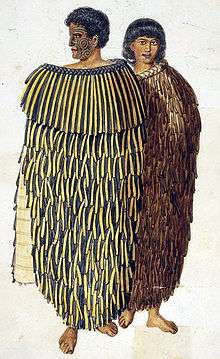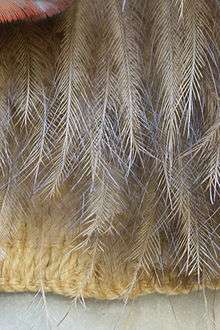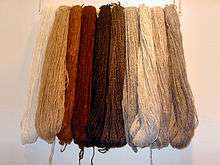Māori traditional textiles
Māori traditional textiles are the indigenous textiles of the Māori people of New Zealand. The organisation Te Roopu Raranga Whatu o Aotearoa, the national Māori weavers' collective, aims to preserve and foster the skills of making and using these materials.

Fibres and dyes
Māori made textiles from a number of plants, including harakeke (New Zealand flax), wharariki, tī kōuka, tōī, pingao, kiekie and toetoe—although the paper mulberry was introduced by Māori, who knew it as aute,[1] it seems not to have thrived and bark cloth (tapa) was always rare.[2]
The prepared fibre (muka) of the New Zealand flax (Phormium tenax) became the basis of most clothing. The flax leaves were split and woven into mats, ropes and nets but clothing was often made from the fibre within the leaves. The leaves were stripped using a mussel shell, dressed by soaking and pounding with stone pounders, (patu muka),[3] to soften the fibre, spun by rolling the thread against the leg and woven. The fibre within the flax is called muka.[4]
Colours for dyeing muka were sourced from indigenous materials. Paru (mud high in iron salts) provided black, raurekau bark made yellow, and tānekaha bark made a tan colour. The colours were set by rolling the dyed muka in alum (potash).
Garments
There were two main types of garments -
- A knee length kilt-like garment worn around the waist and secured by a belt
- And a rectangular garment worn over the shoulders. This might be a cape-like garment or a long cloak-like garment of finer quality.
Men's belts were known as tatua and women's as tu. The man's belt was usually the more ornate. Belts were usually made of flax but occasionally other materials were used such as kiekie and pingao. Flax belts were often plaited in patterns with black and white stripes. The belts tied with a string tie. Women often wore a belt composed of many strands of plaited fibre.
Seeding process
The weaving process (whatu) for clothing was performed not with a loom and shuttle but with the threads being manipulated and tied with fingers. A strong thread is fastened tautly in a horizontal position between two or four upright weaving sticks (turuturu). To this thread (tawhiu) are attached the upper ends of the warp or vertical threads (io). The warp is arranged close together. The weaving process consisted of working in cross-threads from left to right. The closer these threads are together, the tighter the weave, and the finer the garment.
In the case of fine garments four threads are employed in the forming of each aho. The weaver passes two of these threads on either side of the first io or vertical thread, enclosing it. In the continuing the process the two pairs of threads are reversed, those passing behind the first vertical thread would be brought in front of the next one, then behind the next and so on. Each of the down threads would be enclosed between two or four cross-threads every half inch or so.[5]
Pake/Hieke
To meet the cold and wet conditions of the New Zealand winter, a rain cloak called pake or hieke was worn. It was made from tags of raw flax or Cordyline partly scraped and set in close rows attached to the muka or plaited fibre base.
A type of garment known as a pake karure was made of two-ply closed strands of hukahuka (twisted or rolled cord or tag) interspersed with occasional black-dyed two-ply open type karure (loosely twisted) muka thread cord. Garments such as these were worn interchangeably either around the waist as a piupiu, or across the shoulder as a cape. These types of garments are thought to pre-date European contact, later becoming a more specialised form during the mid to later nineteenth century, which continues today in the standardised form of the piupiu.[6]
Piupiu

Piupiu are a kind of grass skirt. The waistband is plaited or in some cases made from tāniko. The body of the piupiu is usually made from flax leaves that are carefully prepared with the muka or flax fibre exposed in some sections to cause geometric patterns to emerge. The unscraped leaves will curl naturally into tubes as the leaves dry, and make a percussion sound when the wearer sways or moves. The geometric patterns can be emphasised through dyeing as the dye will soak more into the exposed fibres rather than the dried raw leaf.[7]
The captain of HMS New Zealand, a battlecruiser funded in 1911 by the government of New Zealand for the defence of the British Empire and which took an active part in three battles of the First World War, wore into battle a piupiu (as well as a hei-tiki, Māori traditional pendant). The crew attributed to this the New Zealand being a "lucky ship" which sustained no casualties during the entire war.
Fine cloaks
_ATLIB_324533.png)
There were a number of different types of fine cloaks including korowai, kaitaka, kahu huruhuru and kahu kurī, all woven from muka (prepared harakeke fibre) using the tāniko technique.
Korowai
Korowai are finely woven cloaks covered with muka tassels (hukahuka). Hukahuka are made by the miro (twist thread) process of dying the muka (flax fibre) and rolling two bundles into a single cord which is then woven into the body of the cloak. There are many different types of korowai that are named depending on the type of hukahuka used as the decoration. Korowai karure have tassels (hukahuka) that appear to be unravelling. Korowai ngore have hukahuka that look like pompoms. Korowai hihima had undyed tassels.
Korowai seem to have been rare at the time of Captain Cook's first visit to New Zealand because they do not appear in drawings made by his artists. But by 1844, when George French Angas painted historical accounts of early New Zealand, korowai with their black hukahuka had become the most popular style. Hukahuka on fine examples of korowai were often up to thirty centimetres long and when made correctly would move freely with every movement of the wearer. Today, many old korowai have lost their black hukahuka due to the dying process speeding up the deterioration of the muka.[8]
Kaitaka
Kaitaka are cloaks of finely woven muka (Phormium tenax) fibre. Kaitaka are among the more prestigious forms of traditional Maori dress. They are made from muka (flax fibre), which is in turn made from those varieties of Phormium tenax that yield the finest quality fibre characterised by a silk-like texture and rich golden sheen. Kaitaka are usually adorned with broad tāniko borders at the remu (bottom) and narrow tāniko bands along the kauko (sides). The ua (upper border) is plain and undecorated, and the kaupapa (main body) is usually unadorned. There are several sub-categories of kaitaka: parawai, where the aho (wefts) run horizontally; kaitaka paepaeroa, where the aho run vertically; kaitaka aronui or patea, where the aho run horizontally with tāniko bands on the sides and bottom borders; huaki, where the aho run horizontally with taniko bands on the sides and two broad taniko bands, one above the other, on the lower border; and huaki paepaeroa, which has vertical aho with double tāniko bands on the lower border.[9]
Kahu huruhuru

Fine feather cloaks called kahu huruhuru were made of muka fibre with bird feathers woven in to cover the entire cloak. These feather cloaks became more common during between 1850 and 1900, when cloaks were evolving in their production. Some early examples include kahu kiwi (kiwi feather cloak), which used the soft brown feathers of the kiwi (Apteryx spp). Kahu kiwi were regarded as the most prestigious form of kahu huruhuru. Other kahu huruhuru incorporated the green and white feathers of the kereru (New Zealand pigeon: Hemiphaga novaeseelandiae) and blue feathers from the tui (Prosthemadera novaeseelandiae).[10]
Kahu kurī
A particularly rare type of cloak is the kahu kurī, made from strips of dog skin with hair attached taken from the now extinct kurī (Māori dog), a dog that went extinct around the 1870s.[11]
The main body of the cloak is made up of strips of white-haired dog skin of various lengths, which are sewn onto the kaupapa (main body) of the cloak with fine bone needles to form a tightly woven muka (flax fibre) foundation called pukupuku. The pukupuku weaving technique uses the whatu-aho-patahi (single pair twine) method, which is very similar to the decorative geometric tāniko (fine embroidery or weaving in a geometric pattern) border designs usually seen on the kaitaka (fine flax cloak) class of cloak, and forms a thick and heavy protective garment. The awe (the tassels that fringe the outside length of the cloak) is likely to have been taken from the underside of the dog's tail. The kurupatu (plaited hem on the cloak edge) is entirely separate to the main kaupapa and made by threading separate strips together to form a length of collar that has been sewn onto the neck of the finished garment.[12]
Kahu kurī are garments possessing great mana (status) and were highly prized heirlooms. Each garment had its own personal name and its history was carefully preserved right up to the time they passed out of Maori ownership. However, most are in museum collections around the world and have lost their provenance. The possession of a kahu kurī immediately identified the owner as a rangatira (chief) or someone who possessed prestige and position within the hapū (family) or iwi (tribe). They were often exchanged between people of rank on important ceremonial occasions and affirmed both the mana of the giver and the recipient. Kahu kurī were made largely between 1500 and 1850, and it is thought that production had ceased altogether by the early nineteenth century.[12]
There are several different varieties of kahu kurī and some tribal variation in the application of the descriptive terms of these types. Some of the types recorded include topuni, ihupuni, awarua, kahuwaero, mahiti, and puahi, but the construction technique remains essentially the same.[12]
Tāniko
Tāniko (or taaniko) refers to any ornamental border typically found on mats and clothes. Tāniko patterns are very geometric in form because they can be reduced down to small coloured squares repeated on a lattice framework. These base square forms, articulated in the hands of a weaver, constitute the larger diamond and triangle shapes that are visible in all traditional weaving crafts.
Pātiki or pātikitiki (flounder/flat fish: Rhombosolea plebeia) designs are based on the lozenge or diamond shape of the flounder. They can be quite varied within the basic shape.
The kaokao (side or rib) pattern is formed by zigzag lines that create chevrons. These can be horizontal or vertical, open with paces or closed repetitive lines. The design is sometimes interpreted as the arms of warriors caught in haka (fierce rhythmic dance) action.
The niho taniwha (taniwha tooth) pattern is a notched-tooth design found on all types of objects, mats, woven panels, belts, and clothing.
The poutama is a stepped design signifying the growth of man, striving ever upwards.
Tahekeheke (striped) designs refer to any distinct vertical patterning.
The whetū (stars), purapura whetū (weaving pattern of stars) or roimata (teardrop) pattern is a geometric design using two colours and alternating between them at every stitch. This design is associated with the survival of an iwi (tribe), hapū (sub-tribe), or whānau (extended family), the idea being that it is vital to have a large whanau, just as there are many stars in the Milky Way.[13]
See also
References
- Rangi, Te. "Journal of the Polynesian Society: Evolution Of Maori Clothing, By Te Rangi Hiroa, P 25-47". Jps.auckland.ac.nz. Retrieved 2013-12-03.
- Narena Olliver (2010-10-30). "New Zealand Birds | Birds | Maori myth | The Maori Kite, Te Manu Tukutuku or Manu Aute". Nzbirds.com. Retrieved 2013-12-03.
- "Patu muka (flax pounder)", Te Ara
- Museum of New Zealand Te Papa Tongarewa. "Prepared length of Muka (Phormium tenax]) Fibre - Collections Online - Museum of New Zealand Te Papa Tongarewa". Collections.tepapa.govt.nz. Retrieved 2013-12-03.
- Museum of New Zealand Te Papa Tongarewa (1961-02-19). "Collections Online - Museum of New Zealand Te Papa Tongarewa, Wellington, NZ". Retrieved 2019-03-27.
- Museum of New Zealand Te Papa Tongarewa. "Collections Online - Museum of New Zealand Te Papa Tongarewa, Wellington, NZ". Retrieved 2019-03-27.
- Museum of New Zealand Te Papa Tongarewa (1928-02-21). "Collections Online - Museum of New Zealand Te Papa Tongarewa, Wellington, NZ". Retrieved 2019-03-27.
- Museum of New Zealand Te Papa Tongarewa. "Collections Online - Museum of New Zealand Te Papa Tongarewa, Wellington, NZ". Retrieved 2019-03-27.
- Museum of New Zealand Te Papa Tongarewa. "Collections Online - Museum of New Zealand Te Papa Tongarewa, Wellington, NZ". Retrieved 2019-03-27.
- Museum of New Zealand Te Papa Tongarewa. "Collections Online - Museum of New Zealand Te Papa Tongarewa, Wellington, NZ". Retrieved 2019-03-27.
- "Kahu kuri style of cloak". Museum of New Zealand. Retrieved 12 January 2019.
- "Kahu kurī (dog skin cloak) | Part of Taonga Māori Collection". Museum of New Zealand. Retrieved 12 January 2019.
- Museum of New Zealand Te Papa Tongarewa. "Collections Online - Museum of New Zealand Te Papa Tongarewa, Wellington, NZ". Retrieved 2019-03-27.
External links
- Maori Material Culture: Clothing and Adornment An Encyclopedia of New Zealand 1966
- The Maori as He Was: A brief account of Maori life as it was in Pre-European Days by Elsdon Best, New Zealand Texts Collection, pg 192-209
- Catalogue of 19th C South Pacific textiles gathered by Captain Cook. Rare book in William Clements Library, University of Michigan, Ann Arbor.
- Staff Favorite: Tapa Cloth from Captain Cook's Voyages (28 April 2010), Clements Library Chronicles
